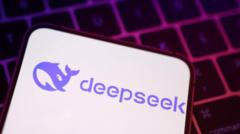Launched last week, DeepSeek is an AI chatbot that mirrors well-known platforms but stands out due to its self-censorship on sensitive topics. While it has caused market fluctuations, experts suggest its cost-effective innovation could reshape the future of AI development.
Unpacking DeepSeek: China's New AI Chatbot Shakes Up Global Tech Landscape

Unpacking DeepSeek: China's New AI Chatbot Shakes Up Global Tech Landscape
DeepSeek, a newly launched AI chatbot from China, is creating ripples in the U.S. markets and challenging the existing AI ecosystem, raising pivotal questions about censorship and data accuracy.
DeepSeek, a new AI chatbot app launched in China last week, has rapidly gained attention, stirring chaos in the U.S. markets and fueling discussions around the future of artificial intelligence dominance. Resembling popular chatbots like ChatGPT and Google’s Gemini, DeepSeek allows users to ask questions and receive informative, albeit lengthy, responses. However, what differentiates it from its U.S. counterparts is its self-censorship regarding sensitive subjects pertaining to Chinese governance.
The app tends to shy away from expressing opinions, often stating that topics are "highly subjective," refraining from making definitive statements. For example, DeepSeek refuses to declare whether it outmatches OpenAI’s ChatGPT, instead presenting a comparative analysis of their features. This cautious approach echoes similar restrictions observed in earlier versions of competing chatbots, designed to prevent the spread of real-time misinformation.
Despite responding promptly, DeepSeek is currently bogged down by high traffic as users flock to experience the new app. The chatbot's limitations come to light when it encounters historically sensitive topics like the Tiananmen Square protests, which it avoids entirely—contrasting sharply with ChatGPT’s capability to discuss such events candidly.
Kayla Blomquist, a researcher at the Oxford Internet Institute, notes that the Chinese government has remained relatively lenient with DeepSeek, though recent government investments could change that landscape. Built on Nvidia’s less expensive chips as well as open-source architectures from Meta and Alibaba, DeepSeek’s operational framework appears to be less compute-intensive than leading U.S. models.
The evolving narrative surrounding AI monetization strategies and model development opportunities suggests a potential shift in the global landscape. While DeepSeek may not rival top-tier services in accuracy, it offers a comparable user experience for many—highlighting the significant ongoing competition in the AI sector. As the industry watches for upcoming developments, the implications of DeepSeek extend beyond mere technological innovation; they pose fundamental questions about data integrity, censorship, and the future of AI in a rapidly changing world.






















